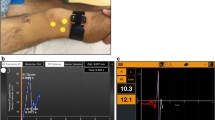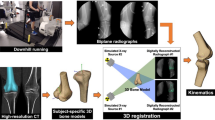Abstract
Purpose/hypothesis
The purpose of this observational study was to determine which factors, including sex, are associated with increased rotatory knee laxity in collegiate athletes with no history of knee injuries. It was hypothesized that increased rotatory knee laxity, measured by a quantitative pivot shift test, would correlate with female sex, increased anterior translation during the Lachman test, generalized ligamentous laxity, and knee hyperextension.
Methods
Ninety-eight collegiate athletes with a median age of 20 (range 18–25) years with no history of knee injuries were tested. IKDC and Marx activity scores were obtained and subjects underwent measurement of anterior translation during the Lachman test with a Rolimeter and measurement of knee hyperextension with a goniometer for both knees. A standardized pivot shift test was performed in both knees and quantified using image analysis technology. Generalized ligamentous laxity was assessed using the modified Beighton score.
Results
The average anterior translation of the lateral compartment during the pivot shift test was 1.6 mm (range 0.1–7.1) with a mean side-to-side difference of 0.6 mm (range 0–2.7). The average anterior translation during the Lachman test was 9.0 (range 2–15). The anterior translation of the lateral compartment during the pivot shift test was significantly higher in females (median, 1.6; range 0.3–4.9) than in males (1.1, 0.1–7.1 mm) (p < 0.05). Anterior translation of the lateral compartment during the pivot shift test was significantly correlated with anterior translation during the Lachman test (r = 0.34; p < 0.05). There was no significant correlation between anterior translation of the lateral compartment during the pivot shift test and knee hyperextension or modified Beighton score (n.s).
Conclusion
The data from this study show that female sex is associated with increased rotatory knee laxity measured during the pivot shift test and anterior translation during the Lachman test in collegiate athletes. In the future, these data may be helpful in diagnosing and managing ACL injuries in athletes and could be used in the clinic as a baseline by which to compare and identify patients who might exhibit increased rotatory laxity.
Level of evidence
Diagnostic level II.

Similar content being viewed by others
References
Agel J, Arendt EA, Bershadsky B (2005) Anterior cruciate ligament injury in national collegiate athletic association basketball and soccer: a 13-year review. Am J Sports Med 33:524–531
Allen MM, Pareek A, Krych AJ, Hewett TE, Levy BA, Stuart MJ, Dahm DL (2016) Are female soccer players at an increased risk of second anterior cruciate ligament injury compared with their athletic peers? Am J Sports Med 44:2492–2498
Arendt E, Dick R (1995) Knee injury patterns among men and women in collegiate basketball and soccer NCAA data and review of literature. Am J Sports Med 23:694–701
Arilla FV, Rahnemai-Azar AA, Yacuzzi C, Guenther D, Engel BS, Fu FH, Musahl V, Debski RE (2016) Correlation between a 2D simple image analysis method and 3D bony motion during the pivot shift test. Knee 23:1059–1063
Ayeni OR, Chahal M, Tran MN, Sprague S (2012) Pivot shift as an outcome measure for ACL reconstruction: a systematic review. Knee Surg Sports Traumatol Arthrosc 20:767–777
Beighton P, Horan F (1969) Orthopaedic aspects of the Ehlers–Danlos syndrome. J Bone Joint Surg Br 51:444–453
Brophy RH, Chiaia TA, Maschi R, Dodson CC, Oh LS, Lyman S, Allen AA, Williams RJ (2009) The core and hip in soccer athletes compared by gender. Int J Sports Med 30:663–667
Brosseau L, Balmer S, Tousignant M, O’Sullivan JP, Goudreault C, Goudreault M, Gringras S (2001) Intra-and intertester reliability and criterion validity of the parallelogram and universal goniometers for measuring maximum active knee flexion and extension of patients with knee restrictions. Arch Phys Med Rehabil 82:396–402
Bull AM, Amis AA (1998) The pivot-shift phenomenon: a clinical and biomechanical perspective. Knee 5:141–158
Conley S, Rosenberg A, Crowninshield R (2007) The female knee: anatomic variations. J Am Acad Orthop Surg 15:S31–S36
Davis I, Ireland ML, Hanaki S (2007) ACL injuries—the gender bias: research retreat III, April 6–8, 2006, Lexington, Kentucky. J Orthop Sports Phys Ther 37:A1–A32
Evans K, Refshauge KM, Adams R (2007) Trunk muscle endurance tests: reliability, and gender differences in athletes. J Sci Med Sport 10:447–455
Ford KR, Myer GD, Toms HE, Hewett TE (2005) Gender differences in the kinematics of unanticipated cutting in young athletes. Med Sci Sports Exerc 37:124–129
Godshall RW (1975) The predictability of athletic injuries: an eight-year study. J Sports Med 3:50–54
Grana WA, Moretz JA (1978) Ligamentous laxity in secondary school athletes. JAMA 240:1975–1976
Gribble PA, Robinson RH, Hertel J, Denegar CR (2009) The effects of gender and fatigue on dynamic postural control. J Sport Rehabil 18:240–257
Harmon KG, Ireland ML (2000) Gender differences in noncontact anterior cruciate ligament injuries. Clin Sports Med 19:287–302
Hatcher J, Hatcher A, Arbuthnot J, McNicholas M (2005) An investigation to examine the inter-tester and intra-tester reliability of the Rolimeter® knee tester, and its sensitivity in identifying knee joint laxity. J Orthop Res 23:1399–1403
Hewett TE, Ford KR, Hoogenboom BJ, Myer GD (2010) Understanding and preventing acl injuries: current biomechanical and epidemiologic considerations—update 2010. N Am J Sports Phys Ther 5:234–251
Hewett TE, Ford KR, Myer GD (2006) Anterior cruciate ligament injuries in female athletes: part 2, a meta-analysis of neuromuscular interventions aimed at injury prevention. Am J Sports Med 34:490–498
Hewett TE, Lindenfeld TN, Riccobene JV, Noyes FR (1999) The effect of neuromuscular training on the incidence of knee injury in female athletes. A prospective study. Am J Sports Med 27:699–706
Hewett TE, Myer GD, Ford KR, Heidt RS, Colosimo AJ, McLean SG, van den Bogert AJ, Paterno MV, Succop P (2005) Biomechanical measures of neuromuscular control and valgus loading of the knee predict anterior cruciate ligament injury risk in female athletes: a prospective study. Am J Sports Med 33:492–501
Hoshino Y, Araujo P, Ahlden M, Moore CG, Kuroda R, Zaffagnini S, Karlsson J, Fu FH, Musahl V (2012) Standardized pivot shift test improves measurement accuracy. Knee Surg Sports Traumatol Arthrosc 20:732–736
Hoshino Y, Araujo P, Ahldén M, Samuelsson K, Muller B, Hofbauer M, Wolf MR, Irrgang JJ, Fu FH, Musahl V (2013) Quantitative evaluation of the pivot shift by image analysis using the iPad. Knee Surg Sports Traumatol Arthrosc 21:975–980
Hoshino Y, Kuroda R, Nagamune K, Yagi M, Mizuno K, Yamaguchi M, Muratsu H, Yoshiya S, Kurosaka M (2007) In vivo measurement of the pivot-shift test in the anterior cruciate ligament–deficient knee using an electromagnetic device. Am J Sports Med 35:1098–1104
Jonsson H, Riklund-Ahlstrom K, Lind J (2004) Positive pivot shift after ACL reconstruction predicts later osteoarthrosis: 63 patients followed 5–9 years after surgery. Acta Orthop Scand 75:594–599
Kanamori A, Woo SLY, Ma CB, Zeminski J, Rudy TW, Li G, Livesay GA (2000) The forces in the anterior cruciate ligament and knee kinematics during a simulated pivot shift test: A human cadaveric study using robotic technology. Arthroscopy 16:633–639
Kim SJ, Lee SK, Kim SH, Kim SH, Kim JS, Jung M (2014) Does anterior laxity of the uninjured knee influence clinical outcomes of ACL reconstruction? J Bone Joint Surg Am 96:543–548
Kocher MS, Steadman JR, Briggs KK, Sterett WI, Hawkins RJ (2004) Relationships between objective assessment of ligament stability and subjective assessment of symptoms and function after anterior cruciate ligament reconstruction. Am J Sports Med 32:629–634
Lane CG, Warren R, Pearle AD (2008) The pivot shift. J Am Acad Orthop Surg 16:679–688
Leitze Z, Losee RE, Jokl P, Johnson TR, Feagin JA (2005) Implications of the pivot shift in the ACL-deficient knee. Clin Orthop Relat Res 436:229–236
Levins JG, Sturnick DR, Argentieri EC, Gardner-Morse M, Vacek PM, Desarno MJ, Tourville TW, Slauterbeck JR, Beynnon BD (2016) Geometric risk factors associated with noncontact anterior cruciate ligament graft rupture. Am J Sports Med 44:2537–2545
Lonner JH, Jasko JG, Thomas BS (2008) Anthropomorphic differences between the distal femora of men and women. Clin Orthop Relat Res 466:2724–2729
Magnussen RA, Reinke EK, Huston LJ, Hewett TE, Spindler KP (2016) Effect of high-grade preoperative knee laxity on anterior cruciate ligament reconstruction outcomes. Am J Sports Med 44:3077–3082
Magnussen RA, Reinke EK, Huston LJ, Hewett TE, Spindler KP, Group M (2016) Factors associated with high-grade Lachman, pivot shift, and anterior drawer at the time of anterior cruciate ligament reconstruction. Arthroscopy 32:1080–1085
Markolf KL, Jackson SR, McAllister DR (2010) Relationship between the pivot shift and Lachman tests: a cadaver study. J Bone Joint Surg Am 92:2067–2075
Muller B, Hofbauer M, Rahnemai-Azar AA, Wolf M, Araki D, Hoshino Y, Araujo P, Debski RE, Irrgang JJ, Fu FH, Musahl V (2016) Development of computer tablet software for clinical quantification of lateral knee compartment translation during the pivot shift test. Comput Methods Biomech Biomed Eng 19:217–228
Musahl V, Griffith C, Irrgang JJ, Hoshino Y, Kuroda R, Lopomo N, Zaffagnini S, Samuelsson K, Karlsson J (2016) Validation of quantitative measures of rotatory knee laxity. Am J Sports Med 44:2393–2398
Musahl V, Hoshino Y, Ahlden M, Araujo P, Irrgang JJ, Zaffagnini S, Karlsson J, Fu FH (2012) The pivot shift: a global user guide. Knee Surg Sports Traumatol Arthrosc 20:724–731
Myer GD, Ford KR, Paterno MV, Nick TG, Hewett TE (2008) The effects of generalized joint laxity on risk of anterior cruciate ligament injury in young female athletes. Am J Sports Med 36:1073–1080
Rozzi SL, Lephart SM, Gear WS, Fu FH (1999) Knee joint laxity and neuromuscular characteristics of male and female soccer and basketball players. Am J Sports Med 27:312–319
Ryan J, Magnussen RA, Cox CL, Hurbanek JG, Flanigan DC, Kaeding CC (2014) ACL reconstruction: do outcomes differ by sex? A systematic review. J Bone Joint Surg Am 96:507–512
Vacek PM, Slauterbeck JR, Tourville TW, Sturnick DR, Holterman LA, Smith HC, Shultz SJ, Johnson RJ, Tourville KJ, Beynnon BD (2016) Multivariate analysis of the risk factors for first-time noncontact ACL injury in high school and college athletes: a prospective cohort study with a nested, matched case-control analysis. Am J Sports Med 44:1492–1501
Varadarajan KM, Gill TJ, Freiberg AA, Rubash HE, Li G (2009) Gender differences in trochlear groove orientation and rotational kinematics of human knees. J Orthop Res 27:871–878
Wahl CJ, Westermann RW, Blaisdell GY, Cizik AM (2012) An association of lateral knee sagittal anatomic factors with non-contact ACL injury: sex or geometry? J Bone Joint Surg Am 94:217–226
Zazulak BT, Ponce PL, Straub SJ, Medvecky MJ, Avedisian L, Hewett TE (2005) Gender comparison of hip muscle activity during single-leg landing. J Orthop Sports Phys Ther 35:292–299
Author information
Authors and Affiliations
Contributions
TP, AK, EH, KN, AA, and CM were involved in the acquisition of data. TP, AK, AP, and VM were involved in the interpretation and analysis of the data. AK and TP drafted the original manuscript. RD and VM conceived and designed the original project. All authors read and approved the final manuscript.
Corresponding author
Ethics declarations
Conflict of interest
All other authors declare that they have no conflict of interest related to this study.
Funding
Funding for this project was generously provided by the Coulter Foundation at the University of Pittsburgh.
Ethical approval
Approval was obtained from the University of Pittsburgh Institutional Review Board (PRO15050261).
Informed consent
Informed consent was obtained from all individual participants included in the study.
Additional information
Investigation performed at the University of Pittsburgh Medical Center, Pittsburgh, Pennsylvania.
Rights and permissions
About this article
Cite this article
Pfeiffer, T.R., Kanakamedala, A.C., Herbst, E. et al. Female sex is associated with greater rotatory knee laxity in collegiate athletes. Knee Surg Sports Traumatol Arthrosc 26, 1319–1325 (2018). https://doi.org/10.1007/s00167-017-4684-6
Received:
Accepted:
Published:
Issue Date:
DOI: https://doi.org/10.1007/s00167-017-4684-6




